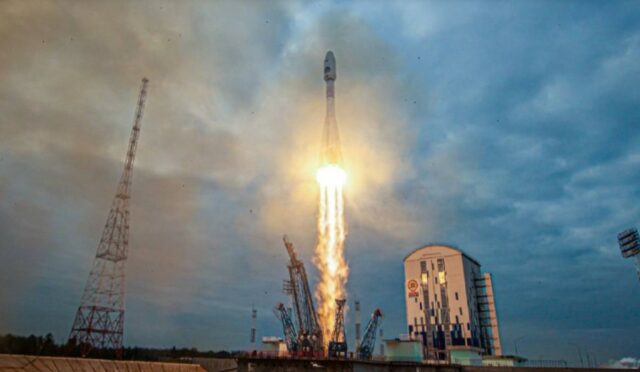
Russia’s Uncertain Aims for Moon Exploration
Publication: Eurasia Daily Monitor Volume: 20 Issue: 130
By:

On August 11, Russia launched its long-delayed Luna-25 mission to the Moon, with the probe aiming to land on the lunar surface in the coming days (TASS, August 11). The main purposes of the Luna-25 launch include the demonstration of Moscow’s technological prowess and landing on the Moon as a practice run of sorts before the launch of other planned missions with more-advanced scientific equipment—namely, Luna-26 and Luna-27, which are scheduled for 2027–2028. However, the Luna-25 mission as well as the whole of Russia’s Moon exploration program have been developed within the framework of extending space cooperation with European partners, the United States, Japan and Canada. In the absence of such cooperation, the probability of the successful realization of the Luna-26 and Luna-27 missions is relatively low. Moreover, the Russian Lunar program has already faced serious cuts and lost its main strategic purpose.
The Luna-25 project (previously known as “Luna-Glob”) first appeared in the late 1990s. It was developed in cooperation with American and European scientists, relying heavily on European-made electronics and components. It was initially scheduled for launch in 2014 in partnership with India and its own lunar program. Then, however, numerous delays appeared. Since its annexation of Crimea, Moscow has conducted a campaign of sourcing substitute imported components onboard Luna-25, and India moved forward without Russia. Overall, the substitution of imported components led to a significant increase in mass from 590 kilograms (kg) of dry weight in 2016 to almost 751 kg in 2021, with the weight of scientific equipment remaining around 30 kg (Iki.rssi.ru, 2011; RIA Novosti, June 19, 2015; Laspace.ru, 2016; Sciencejournals.ru, 2021; RT, August 7).
Luna-25’s problems, in turn, delayed the planned Luna-26 and Luna-27 missions, formerly known as “Luna-Resurs-Orbital” and “Luna-Resurs-Landing,” respectively. Being more advanced, these two probes are even more dependent on international cooperation as compared to Luna-25. For example, preparations for Luna-26 relied on partnerships with research organizations in France, Japan, the Czech Republic, Slovakia and Sweden, and it is unclear how far Russia has already moved in redesigning the mission. Planning for the Luna-27 probe was also dependent on partnerships with the European Space Agency as well as national universities and research institutions of a number of European Union member states. And the substitution of imported equipment for this particular probe only just started at the beginning of 2023. Consequently, the rescheduled term for these two missions, 2027–2028, may be considered an optimistic prediction against the backdrop of these growing problems (TASS, July 18; Iki.cosmos.ru, accessed August 14).
Furthermore, next steps were already being planned for Russia’s Luna-28 sample return probe and manned Lunar program in close cooperation with the United States and other International Space Station partners within the US manned Lunar program. Nevertheless, as can be expected, Luna-28 has been postponed indefinitely: instead of the originally planned launch for 2024, now it is planned for “2030 or later” without any clear mission design. Briefly speaking, for all intents and purposes, the Kremlin has cut the Luna-28 project (Laspace.ru, 2016; TASS, August 10; Laspace.ru, accessed August 14).
Regarding the manned Lunar program, Russia had been driving a hard bargain with the United States during the past several years until 2022. In this, the Kremlin tried to push the technological, financial and political preferences for Roscosmos’ participation in the National Aeronautics and Space Administration’s, or NASA’s, Gateway project and Artemis program at that time. Yet, after Moscow’s full-scale invasion of Ukraine, such prospect have become almost impossible to implement (RBC, September 24, 2018; RBC, November 2, 2018; Kommersant, June 4, 2021; RBC, April 29, 2022).
Even Russia’s bet on a partnership with the People’s Republic of China in Lunar exploration, including manned expeditions on the Moon’s surface, looks like wishful thinking with the absence of the proper technologies, equipment, components and even launch vehicles and spacecraft on the Russian side. Moreover, during Chinese President Xi Jinping’s visit to Moscow in March 2023, no clear prospect was declared for Russian-Chinese space cooperation beyond 2027 (Roscosmos.ru, June 16, 2021; RIA Novosti, December 21, 2022; Kremlin.ru, March 21; TASS, August 10).
For now, the Russian Lunar program is driven by the inertia of previous planning and by political motivations: the Kremlin is trying to prove its economic and technological capacity and autonomy in outer space and its political and moral supremacy in the war against Ukraine and in its confrontation with the West. Russia’s program does not have any clear prospects besides the Luna-25, Luna-26 and Luna-27 probes. And even the last two missions, Luna-26 and Luna-27, are completely dependent on Moscow’s capacity to substitute foreign components and onboard scientific equipment for its spacecraft—and the full extent of that capacity remains unclear.



